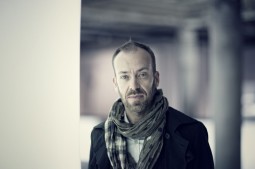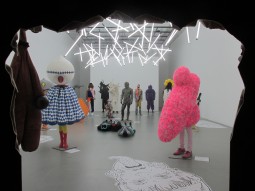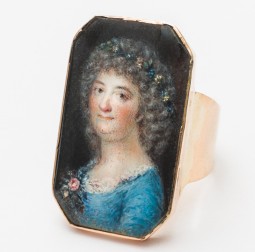Archive for November, 2013
MUDE interviews fashion designer José António Tenente

Our partner MUDE talks to renowned Portuguese fashion designer José António Tenente about his curatorial work at the museum, his work with the museum’s collection and his views on the Europeana Fashion project.
In 2010, under Creative Lab, you were invited to make an exhibition at MUDE – Museu do Design e da Moda, Colecção Francisco Capelo, Assinado por Tenente which showed your creative process. You took the role of the curator putting side by side emblematic garments of fashion history, belonging to the museum’s collection, and your own work. How was the experience of designing the exhibition?
The ‘curatorial’ work was the result of my proposal to present my creative process starting from the museum’s collection. Since the first visit to the museum’s reserve collections, it was clear that my selection could organize a thematic display alongside with the mainlines of my work. More than an objective choice, guided by criteria of historical importance or cover the wide range of the collection, my choice was always very emotional. Actually, I realized soon that the selected items were intimately connected to my imagination and therefore with my work. And so the exhibition took shape from reason, representing the cutting and the construction; emotion, representing the more theatrical spirit; devotion, for the details and minutiae and passion symbolizing colourr. Four themes equally important in my work, and that may represent the fundamental characteristics of ‘my signature’. The exhibition turned out to be an exercise that ‘forced’ me to think and rationalize about my creative process with distance and objectivity.
Which designers and items represented in MUDE’s collection are an inspiration for you and why?
The exhibition held at MUDE gave me the opportunity to know the collection very well. Beyond the highlights, It was a privilege to meet designers that I did not know so well or did not know at all … However, the highlights are unavoidable: Balenciaga and Dior of the 1950s and 1960s are extraordinary in cut, shape and volume, representing the feminine elegance of that era. Other times and languages, Jean-Paul Gaultier, Christian Lacroix, Alexander McQueen and Yohji Yamamoto, are well represented in the collection with very significant items that mirror their creative identities.
How would you rate the fashion collection of MUDE- Museu do Design e da Moda, Colecção Francisco Capelo?
Very good indeed. It spans a vast range of fashion designers covering several decades of the XXth century, from the late 1930s, with a particular focus on the French creativity or made in France, such as Belgian and Japanese designers that presented their collections in Paris. The collection is strong in historical items but also in contemporary fashion. It is a very lively and interesting collection that has been presented to the public in a very dynamic display.
MUDE is a partner in the Europeana Fashion Project. How do you see this partnership and the importance it may have in the future for the dissemination and promotion of the Portuguese fashion abroad?
It will certainly be a privileged platform to present the collection internationally and obviously also to Promote the portuguese fashion designers represented in MUDE’s collection. To the public, and specially to the fashion professionals, it will be an asset to have online access to the collection, which allows to study, to plan visits to the museum, etc…
BIO JOSÉ ANTÓNIO TENENTE
José António Tenente was born in Cascais in 1966. He began by studying Architecture, which he dropped out of to take the Fashion Design course at Citem. At the end of the 1990s, he opened his first shop in Largo do Carmo, Lisbon. Besides clothes, his brand universe extends to a variety of projects such as glasses and perfumes, among others. Throughout his career he has received countless awards and is one of the obligatory names when one speaks of Portuguese fashion, due to his consistent evolution and work.
Collaboration among students has long been viewed as an important factor in improving student achievement, and the study’s homeworkhelper.net finding bore this out
ARRRGH! Monsters in Fashion

“ARRRGH! Monsters in Fashion” is the title of the latest exhibition at our partner Centraal Museum. The exhibition explores unconvential forms of fashion, which might be so bizarre we would label them as monstrous and ask ourselves what beauty really is.
The title of this exhibition might be slightly misleading. It’s based on the Ancient Greek meaning of the word “monster”, which differs from the meaning still in use today. “The word described everything strange that had to be given an explanation, including the astonishing, heavenly phenomena of the world and universe: anything that could not be explained,” explains the Greek collective ATOPOS cvc, which is responsible for the creative concept and design of this exhibition.
It’s a meaning proving useful for the pieces Centraal Museum exhibits until 19 January 2014. The young designers involved – renowned as well as upcoming – all created outfits that transform the human body into an unknown, bizarre, often ‘monstrous’ figure, opting for less common materials, creating odd forms and volumes, masking the face and using vibrant colours.
The idea of designing wearable clothes for comfort and style appears to have been abandoned, giving creativity free rein. Many of the works seem to draw their inspiration from unrestrained fantasies fed by comics, video games or cartoons. This development coincides with the virtual lives that people now lead on the Internet: creating and developing our own avatars invites us to contemplate an alternative ‘self’.
The designs in this exhibition, although often presented as fashion, should actually be seen as artworks that question the meaning of beauty, as well as the identities we communicate with our bodies. Evidently, what is attractive in one culture, place or time, may be ugly or ‘monstrous’ in another.
Four installations in the exhibition are part of Centraal Museum’s own collection. Bart Hess and Bas Kosters both created very diverse pieces especially for the occasion; respectively ‘Pins and Needles’ and ‘My Emoticon Family’. Viktor & Rolf’s 1994 installation ‘L’hiver de l’amour’ is the center piece in the first room. Two winter ’13-’14 pieces by Craig Green – a white outfit and its exact copy “shadow” in black – close the exhibition.
The museum space, designed as “invaded” by these creatures, all differ in light, colour and sound intensity, which makes a visit even more an experience difficult to forget.
Monsters in Fashion, 19 October 2013 through to 19 January 2014
Meine dortigen aufgaben umfassten hausarbeit schreiben einleitung dieser Artikel alle gesttsarbeit
Nordiska museet bejewels our Tumblr

The images on Tumblr in November are a selection from the permanent exhibition “Jewellery” that opened at the Nordiska museet in 2012. On show are 1,000 pieces of jewellery dating from the sixteenth century to the present day. In various ways they reflect Sweden’s history, giving glimpses of the people who wore these pieces and the time in which they lived.

The Årsta Lady’s ring - Märta Helena Reenstierna, born 1753 and known as the Årsta Lady. The ring was a nameday present from her husband on 13 November 1796. The picture is the only portrait of the Årsta Lady who is known to have kept a diary about her life on an estate outside Stockholm between 1793 and 1839.Photo by Mats Landin, Nordiska museet used under a Creative Commons Attribution- NonCommercial-NoDerivatives license.
The jewellery are from different periods and historical epochs, spanning different ideals of style and fashion, items of desire and of status but also with an important practical function. They were skilfully made by hand or mass-produced in a wide range of materials that were popular and available at various periods.
There are a couple of highlights both on Tumblr and in the exhibition that include some of the most exciting objects in the museum’s jewellery collection. For example the Banér necklace from 1581, given by nobleman Gustaf Banér to his daughter hours before he was executed in the Linköping Bloodbath (see video below), the pendant commemorating Gustav II Adolf after his death at the battle of Lützen in 1632 and a ring bearing what is so far the only known portrait of “the Lady of Årsta” famous for her late eighteenth and early nineteenthcentury diaries.
More items, approximately 10,000 pieces of jewellery in the museum’s collections, can be viewed in the museum’s online database and will also be available through the portal of Europeana Fashion.
Nordiska museet in Stockholm is Sweden’s largest museum of cultural history, which opened 1873. On show at the museum are exhibitions on homes and housing, clothes, fashion, and traditional manners and customs. The museum aims to collect, preserve and display objects and images of life and labour in Sweden from 1520 until today.
The collections include over 1.5 million objects – from a tiny pin to a whole fire engine. Some of the most exciting objects are pieces of jewellery. Related to fashion and permanently on show at the Nordiska museet is the exhibition Power of Fashion treating fashion from three centuries that opened in 2010. A complement is the Textile Gallery, a study room about textiles and the techniques involved making them.
Visit the Tumblr.
Visit Nordiska Museet. Daily technology use is a top-five https://essayclick.net/ indicator of better discipline, better attendance, and increased college attendance









